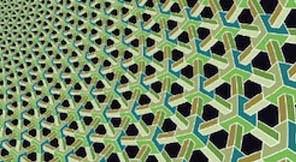MEMS Fractal Capacitor Operates Beyond 20 GHz, Enabling Use in High andwidth Applications
Using fractal geometry to enhance efficiency and increase resonant frequency

A novel microelectromechanical system (MEMS) capacitor operates at a resonant frequency beyond 20 gigahertz (GHz), improving performance within high radio frequency (RF) bands. This patentpending innovation uses fractal geometry to reduce parasitic capacitance, enhance the Qualityfactor (Qfactor), and increase resonant frequency. The MEMS capacitor requires no fabrication intervention or postprocessing, which facilitates its assimilation into an integrated circuit design. The technology has been prototyped in static capacitors but also works with variable (tunable) capacitors. Because the device offers higher resonant frequency, it can be used for high bandwidth applications including satellite communications, mobile handheld devices, and RF MEMS transceivers.
Technology Summary
Fractal capacitors, introduced initially in complementary metal oxide semiconductor (CMOS) technologies, are a potential solution for increasing capacitance density. They do not rely solely on the typical vertical capacitance present between two different layers but also benefit from horizontal capacitances, given the continuous and fast downscaling of lateral dimensions in processes.
How It Works
 In this patent-pending innovation, a fractal capacitor is applied to a MEMS format. The device generates capacitance in a single layer far from the substrate, significantly reducing parasitic capacitance while simultaneously increasing Q-factor and resonant frequency.
In this patent-pending innovation, a fractal capacitor is applied to a MEMS format. The device generates capacitance in a single layer far from the substrate, significantly reducing parasitic capacitance while simultaneously increasing Q-factor and resonant frequency.
Fractal structures (geometric configurations built from the repetition of a simple shape) are helpful in increasing capacitance density because they exploit lateral fringing fields in cross-connected layers. This innovation employs Moore’s fractal shape because it contains right angles only, which is compatible with all CMOS and MEMS processes.
A KAUST-led measurement demonstrated a self-resonant frequency in excess of 20 GHz, which extends its use to high bandwidth RF applications. Additionally, Q-factors of 28 at 5 GHz and higher than 4 for a band of 115 GHz were recorded. Because MEMS fractal structures are flexible, designers can customize specific processes in a typical clean room with relative ease and within usual fabrication limits. The invention takes a step toward seamless integration of MEMS and CMOS technologies. The goal is for components to be designed and built within the same foundry instead of soldering components together separately.
Why It Is Better
The fractal design and single layer approach of the KAUST technology offers advantages over the standard MEMS parallel plate design and over CMOS fractals. Because of the configuration of the conductive plate in previously reported designs, unwanted parasitic or unintentional capacitance is generated. The KAUST innovation suppresses this parasitic capacitance because the signal and ground terminals are on the same plane and there are no top and bottom plates. Resonant frequency and Qfactor increase simultaneously. In addition, the geometry also almost completely eliminates the problematic plate warping that can be destructive to the functionality of any MEMS device.
IP Protection
KAUST has several patents pending for this technology.
Invention Track Code
2011-081

Benefits
- Efficient: Reduces parasitic capacitance, which increases the capacitor’s Qfactor to 28 at 5 GHz and to at least 4 for up to 15 GHz
- High performance: Increases resonant frequency to at least 20 GHz, which allows for use in higher bandwidth applications
- Robust: Suppresses the problematic plate warping usually present in MEMS parallel plate capacitors
- Expedient: Eliminates the need for etching holes, depending on the basic fractal geometrical shape that creates the overall fractal structure

Applications
- Smart phones
- RF MEMS electronics
- Mobile handheld devices
- Broadband services
- Integrated circuit and electronics manufacturing
- Satellite communications for highspeed Internet
- Aeronautical navigation
- Inflight passenger Internet and entertainment functions
- Capacitive and humidity sensors
